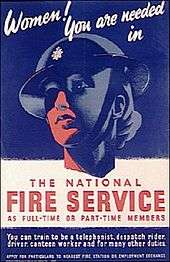National Fire Service
The National Fire Service (NFS) was the single fire service created in Great Britain in 1941 during the Second World War; a separate National Fire Service (Northern Ireland) was created in 1942.[1]

The NFS was created in August 1941 by the amalgamation of the wartime national Auxiliary Fire Service (AFS) and the local authority fire brigades (about 1,600 of them). It existed until 1948, when it was again split by the Fire Services Act 1947, with fire services reverting to local authority control, although this time there were far fewer brigades, with only one per county and county borough.
The NFS had full-time and part-time members, male and female. Its uniform was the traditional dark blue double-breasted tunic, and it adopted the peaked cap worn by the AFS instead of the peakless sailor-style cap which had been worn by many pre-war fire brigades (including the London Fire Brigade). The peaked cap was retained by fire services after the war.
When they were on duty, but in the frequent long stretches between calls, many firemen and firewomen performed vital wartime manufacturing work, in workshops in the fire stations or adjacent to them. This was entirely voluntary, but since many of the wartime personnel had worked in factories before the war it was work with which they were familiar and skilled.
War service meant considerable risk, and members of the NFS were called to attend the aftermath of German bombing raids and coastal shelling from France, or often whilst these attacks were still ongoing. Casualties were inevitable, and there is one record of one volunteer who died on duty aged just 19, and was awarded the Certificate for Gallantry as a result.[2] He is buried in the Hamilton Road Cemetery, Deal, Kent.
The Chief of the Fire Staff and Inspector-in-Chief throughout the war (until 28 February 1947, when he retired) was Sir Aylmer Firebrace, former Chief Officer of the London Fire Brigade.
At peak strength the NFS had 370,000 personnel, including 80,000 women.[3] The women were mostly employed on administrative duties.
The NFS was divided into about forty Fire Forces. These were subdivided into Divisions. Each Division had two Columns and each Column had five Companies.
Ranks
| National Fire Service Ranks[4] | ||||||
|---|---|---|---|---|---|---|
| Men | Women | Police equivalent[5] | ||||
| Insignia[6] | Rank | Number in April 1947 | Rank | Number in April 1947 | London | Outside London |
| Fireman | Firewoman | Constable | Constable | |||
| Leading Fireman | Leading Firewoman | |||||
| Section Leader | Senior Leading Firewoman | Sergeant | Sergeant | |||
| Company Officer | 1,100 | Assistant Group Officer | 50 | Inspector | Inspector | |
| Senior Company Officer | 250 | Group Officer | 27 | Sub-Divisional Inspector | Chief Inspector | |
| Column Officer | 382 | Assistant Area Officer | 1 | Chief Inspector | Superintendent | |
| Divisional Officer | 194 | Area Officer | 11 | Superintendent | Chief Superintendent | |
| Assistant Fire Force Commander | 52 | Regional Woman Fire Officer | 3 | Deputy Commander | ||
| Fire Force Commander | 53 | Commander | ||||
| Chief Regional Fire Officer | ||||||
 | Senior Staff Officer | |||||
 | Inspector | |||||
 | Chief of the Fire Staff & Inspector-in-Chief | 1 | ||||
Notable members
- Sir Frederick Delve (career firefighter and fire service administrator)
- Leslie Leete (career firefighter - later successor to Delve as chief officer of London Fire Brigade)
Members of the NFS who were well known in civilian life (or later became so) included:
- A. L. Barker, writer (NFS telephonist)
- Paul Brooks, cricketer (served in London and Coventry)[7]
- Jack Dash, trade unionist and communist
- Cyril Demarne, writer
- Lewis Dorey, cricketer
- Charles Hadfield, canal historian
- Brian Moore, writer (1941–1942; served in Belfast)
- Ernest Race, furniture designer
- George Rudé, historian (served in London)
- Audrey Russell, radio broadcaster (1941–1942)
- William Sansom, writer
- Sir Stephen Spender, writer (1941–1944)
- Phyllis Stedman, Baroness Stedman, politician (1941–1944; Group Officer in Derbyshire)
- Irene Thomas, radio personality (1941–1944)
An eleven-minute Second World War documentary that chronicles the birth and work of the NFS survived the war and is available to view on the British Pathe website.[8]
Service personnel received Certificate of Service documents.

Footnotes
| Wikimedia Commons has media related to National Fire Service. |
- Bangor Fire Brigade: A Brief History Archived 2007-09-27 at the Wayback Machine
- http://www.cwgc.org/find-war-dead/casualty/3115241
- Haley, Reginald (January 2012). "Firebrace, Sir Aylmer Newton George (1886–1972)". Oxford Dictionary of National Biography. Oxford University Press. Retrieved 14 July 2013.
- Industrial Court Decision 2088, 1 May 1947
- Pay parity with equivalent police ranks was established from the outset for male officers (Company Officer and above). Firemen and Section Leaders were given parity with police Constables and Sergeants by Industrial Court Decision 2076, 18 December 1946, with Leading Firemen receiving an intermediate rate. Women never had pay parity.
- Talbot-Booth, E.C. (1943). Ranks and Badges in the Navy, Army, RAF and Auxiliaries (PDF). London: George Philip & Son, Ltd. p. 32.
- ""Boy Who Bowled Bradman" Dies of War Injuries". The Advocate. 29 January 1946. p. 1. Retrieved 14 April 2012.
- "The Birth of a Service (1940)". British Pathe Ltd. Archived from the original on 2 March 2011. Retrieved 12 October 2018.